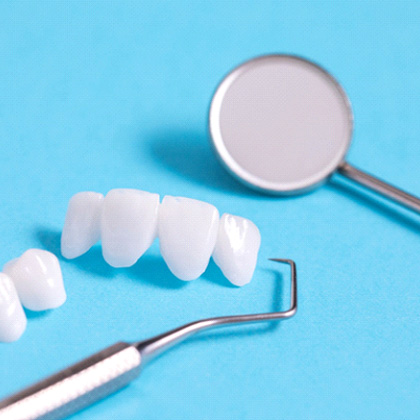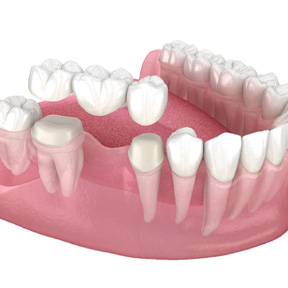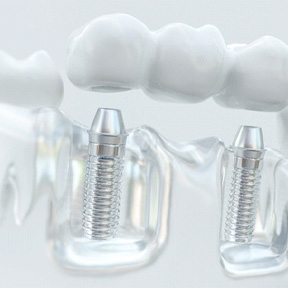Dental Bridges
Replace Multiple Lost Teeth All at Once
Our team here at Lake Nona Dental Group understands the heavy toll that tooth loss can have on your overall well-being and general happiness—after all, your smile is one of your best features and often the first thing that people will notice about you! But among all of the available tooth-restoration options around these days, have you considered dental bridges? They’re one of the go-to options for replacing lost teeth, as they can capably assist your smile in terms of look and functionality. Keep reading to learn a little more about dental bridges in Lake Nona, or feel free to give us a call to request additional information or assistance.
Why Choose Lake Nona Dental Group for Dental Bridges?
- Friendly & Experienced Dental Team
- Modern Office with Advanced Technology
- Beautiful & Natural-Looking Results
What Is a Dental Bridge?

A dental bridge is a fixed device that’s used to close the gap left behind from a lost tooth or teeth. This restoration can be critical in preventing teeth from drifting into this space and causing problems with your bite. They rely on crowns attached to adjacent teeth, or implants embedded within the jawbone, to remain secure. Not only are bridges durable and able to withstand the forces of biting and chewing, but they also look natural and blend in seamlessly with your smile!
Types of Dental Bridges

The only way to determine the best solution for restoring your smile is by visiting us for a consultation; we can inspect your mouth, confirm you’re in good oral health, and verify which type of dental bridge is best for addressing your missing teeth. That said, here’s a little more about each of your options:
Traditional Dental Bridge

For patients missing one or a few teeth in a row, a traditional dental bridge is often the go-to solution. These bridges are anchored to your mouth via crowns placed on the teeth adjacent to the gap. During this process, a small portion of enamel needs to be removed from these teeth so that their crowns fit securely; however, this slight alteration is nothing you need to worry about, as it ultimately ensures the lasting success of the bridge.
Implant Bridge

While traditional bridges rely on adjacent teeth and crowns for support, implant bridges are directly anchored to your jaw with the help of dental implants. The implants are surgically placed on either side of the gap in the smile, and after they’ve fused with the jawbone, the bridge can be attached to replace two or more missing teeth. Due to the impressive level of stability offered by the implants, your restoration will have a much longer lifespan, feel more natural, and return more of your biting power. As an added bonus, this treatment requires no alteration of your existing teeth.
The Benefits of Getting a Dental Bridge

Dental bridges in Lake Nona are accompanied by several incredible benefits, such as:
- Bridges are customized to blend in seamlessly with your natural smile.
- They’re able to replace one or several missing teeth in a row.
- They restore and improve your overall chewing power.
- They help prevent future misalignment issues.
- They’re capable of lasting 10+ years with proper care (or several decades if implant-retained).
Dental Bridges FAQs

We understand that navigating the process for replacing missing teeth can be a little daunting and confusing at times, but there’s no reason to fret; our team is here to assist you with every step of the process! We’ve gathered a few of the most frequently asked questions that we receive about dental bridges in Lake Nona along with their respective answers, so that you can feel confident about committing to treatment. If you have any other questions about dental bridges or your eligibility, don’t hesitate to contact us for additional assistance.
Can You Take a Dental Bridge Out?
The short answer here is no, you cannot simply take out your dental bridge once it’s been placed inside your mouth. Bridges are designed to remain sturdily in place for several years, and only a dental professional can remove it if necessary (such as if it’s failed and needs to be replaced). It’s worth noting that some healthcare providers refer to partial dentures as “removable bridges,” but this is not entirely accurate; although partials are similar to bridges, they’re intended to be removed by the patient at any time, while bridges are not.
Is Getting a Dental Bridge Painful?
Many patients are hesitant about any type of dental work due to concerns about pain; however, before preparing your teeth to support a bridge, we’ll numb the affected area so that you don’t feel an ounce of discomfort. In most cases, a topical anesthetic is all that’s necessary! Following this preparation and the placement of the bridge, the underlying teeth will likely feel sensitive for the next few days. Taking over-the-counter pain medications can usually assist with this discomfort, but you should give us a call if things worsen.
What Can You Not Eat with a Dental Bridge?
Dental bridges enable you to chew most foods with relative ease, but you should still exercise caution around certain foods if you want your bridge to last for as long as possible. Sticky and chewy foods are often the most problematic, as they can loosen your bridge or even pull it right off of your teeth! If possible, avoid items like caramel, fruit gummies, and sticky candies such as taffy. You should also limit your consumption of sugary foods and drinks, since they can cause decay in the teeth surrounding your bridge.
How Long Should a Dental Bridge Last?
On average, you can expect your bridge to last somewhere between 5 and 15 years, but this may vary depending on the material the bridge is made from; metal bridges often have a longer lifespan than metal-free ones, but the difference is usually negligible. The biggest factors that contribute to the overall lifespan of your bridge include diet, oral hygiene, and bad oral habits like smoking, teeth grinding, and nail-biting. It’s also worth noting that bridges used to replace front teeth might last longer than those towards the back of the mouth, as they’re not subjected to quite as much wear and tear from chewing. Implant bridges also tend to last longer than traditional bridges, due to the method in which they’re integrated. But the bottom line is, the healthier your mouth, the longer you can expect your bridge to last!
I Need a Checkup & Cleaning I am Concerned About Bleeding Gums I Have a Cavity or Broken Tooth I am Missing One or More Teeth I Want to Enhance My Smile I Want a Straighter Smile I am in Pain & Need Help I Need My Wisdom Teeth Removed I am Concerned about Sleep Apnea View Our Services


